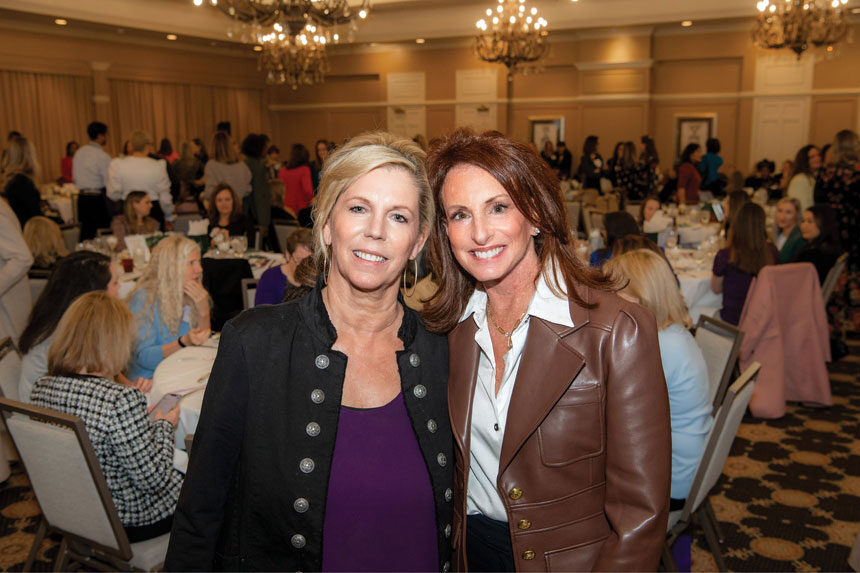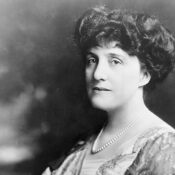Leslie Strittmatter and Terri Stagi guide me past long racks of women’s clothes. Women Giving Back may be a nonprofit — the duo co-founded the organization with a friend in 2007 — but its Sterling, Virginia, warehouse, about 30 miles from D.C., feels more like a Macy’s than a charity. The donated dresses, blouses, suits, shoes, pants, hats (there’s a lot to choose from) are brand name, high-quality, and neatly organized by size. But WGB is about far more than finding a new outfit. For the women who come here — many are homeless, some have fled domestic abuse — shopping for clothes in this free-of-charge boutique is empowering, transformative, and a boost to their self-esteem.
“We want them to feel like they’re here for a nice shopping experience, not that they are in need,” says Stagi. “And sometimes, truly, they’re shellshocked. They’ve been through so much abuse.”
“Homelessness isn’t necessarily what you think it is,” adds Strittmatter. “Sometimes it’s women who got divorced and lost their healthcare, and then they lost their job, and they’re like, ‘Oh my God, I have no income,’ and they end up in transitional housing. We’ve had cases where women come from a middle-class family and there’s domestic violence and they take their kids and run with the clothes on their back.”
They tell me a story from the early days of WGB: A woman came to the store with her daughter, a freshman at the University of Virginia. The mother had suffered domestic abuse, struggled with drugs, and lost her home. She was living in a shelter, and her daughter would stay with her there on breaks from UVA.
“It hit us: They look like us,” Stagi says of their female clients. “That was our first introduction to who we thought we were serving and who we actually saw.”
In the years since, their service to women has only increased. In 2022 alone, WGB served over 24,400 women and children, distributing not just 31,300 articles of clothing, but diapers, school supplies, Halloween costumes, prom dresses, holiday toys, children’s snack packs, and more. During the pandemic, WGB gave food to families in need (“We became like a grocery store,” Strittmatter says). WGB has also worked with partners to send clothes to people in need in 20 other countries, including Venezuela, Ghana, Haiti, Jamaica, India, and Lebanon. Since 2016, WGB has distributed clothing with an in-kind value of $4.4 million.
In the boutique, a prominent banner makes a statement about their work: “Behind every successful woman is a tribe of other successful women who have her back.” For Strittmatter and Stagi, that statement also applies to their own lives. They met in 1985, when they both worked in the building industry — which was challenging for women.
“It was hard then because it was a male-dominated industry,” says Stagi. “It was an old boys club. Women, basically, were slotted into sales and marketing.”
Strittmatter and Stagi started a networking group called the WIRMS: Women in Real Estate Marketing. “Even though we were competitors, we decided we could be more powerful as a group,” Strittmatter says. Those relationships helped fuel the creation of WGB. Stagi was communications chair on the board of HomeAid, a national charity for the homebuilding industry. HomeAid was run by men; Stagi was enlisted to create some programs for women. After learning that homeless shelters needed clothing, she called Strittmatter and another business friend, Fiona Hughes, and they tapped into their WIRM connections.
“We made some phone calls and said, ‘Hey, we’re starting this thing called Women Giving Back,’” says Strittmatter. “‘We’re going to collect clothes for women in shelters.’” At their first event, more than 50 women donated clothes.
Initially, WGB had a small space and limited capacity. “We were open one Saturday a month, nine to noon,” says Strittmatter. “That was all that we could handle. It was all we could do just to get the clothes on the hangers and onto the racks.”
Intense demand spurred quick lessons. When they operated once a month, lines of women would be waiting outside — and the boutique became, as Strittmatter puts it, “a warzone.”
“They would come by bus or by any way they could get here,” she says. “And when we would let the women in, it was bedlam and chaos. Clothes were everywhere. Volunteers were picking up clothes off the floor, women were fighting over clothes. We thought, okay, we have to be open more. And we have to limit how many people can come in at a time. Because we want it to be a dignified environment where people don’t feel like they’re homeless.”
Another problem: “We were getting freeloaders who were taking really good designer stuff and then probably selling it,” Stagi says. “People were pulling up in their Mercedes SUV. So we stumbled our way through a lot of it and slowly learned.”
Today, WGB works with local assistance agencies to schedule 8-10 shopping days per month for about 40 women at a time (it also welcomes about four private groups per month and schedules private emergency appointments). And it continues to offer only high-quality clothes. The idea is simple: If you wouldn’t wear it or give it to someone for a job interview, WGB won’t hang it on the racks. The staff emphasizes that standard to volunteers who sift through donations and community members who contribute clothes (unused clothes are donated elsewhere or sold to textile companies). Like the boutique itself, the quality of the clothes sends a message to WGB’s clients: We respect you — and you deserve this.
WGB even trains volunteers who serve as personal shoppers to assist clients. It also has racks of clothing for children, from infants to teens. That’s important not just financially for homeless moms, but emotionally for their kids.
“If these kids are going to a new school, in most situations, they have one set of clothes,” Stagi says. “And kids are going to be mean. You know, ‘You’re wearing the same clothes.’ So usually a social worker will let us know and we’ll pull a whole wardrobe for these kids, so that they can go to school, and they can blend in, and nobody will know what’s going on at home.”
For Strittmatter and Stagi, the work has been both exhilarating and exhausting, particularly in the early years, when they were juggling careers and families in addition to their new passion. “We were full-time parents, we were full-time employees, we were full-time running this charity,” Strittmatter says. “We were driving around picking up donations. Our cars were completely full of clothes all the time. We were trying to raise money. We would make our husbands come in and help.”
But they never questioned their efforts. “The feeling we got from this was so fabulous,” Stagi says.
In 2015, WGB became a 501(c)(3) nonprofit — which was scary, they admit — and soon hired their first paid staff person, Nicole Morris, as executive director. With Morris overseeing operations and a staffing, Strittmatter and Stagi now focus on fundraising. WGB has developed partnerships with numerous companies, including M&T Bank, Walmart, and T.J. Maxx, which has led in-store toy drives and donated items such as clothes, backpacks, school supplies, and Halloween costumes. The primary goal is for WGB to own its own space — a “forever home,” as they call it — partly to avoid paying rent, partly to have space for more services (volunteers have offered to assist with everything from makeup tips to résumé writing). And of course, they want to provide more clothes.
“Part of getting your dignity back is knowing you look good,” says Stagi. “It sounds a little superficial, but it’s not. When they put something new on, and they know they look good, they get a little smile on their face. And their kids will be like, ‘Oh mom, I love that.’ It’s a little bright spot in their life. They walk out straighter than when they walk in.”
Ken Budd has written for The Atlantic, The Washington Post, National Geographic Traveler, and many more. He is the author of The Voluntourist. You can sign up for his newsletter about giving, travel, and amazing people at kenbudd.us.
This article is featured in the May/June 2023 issue of The Saturday Evening Post. Subscribe to the magazine for more art, inspiring stories, fiction, humor, and features from our archives.
Become a Saturday Evening Post member and enjoy unlimited access. Subscribe now



